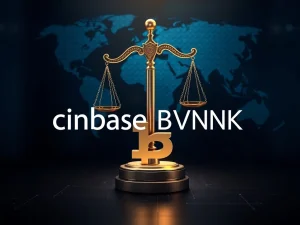Europol SHUTS DOWN Archetyp Dark Web Market, But Ecosystem Adapts

In the world of digital currency and online anonymity, news often breaks that highlights the constant battle between law enforcement and illicit online activities. Recently, a major development occurred that impacts the landscape of the internet’s hidden corners: the shutdown of the Archetyp dark web market. This event sends ripples through the community interested in how digital assets like cryptocurrency are used and regulated, showcasing both the power of international cooperation and the persistent challenges faced by authorities.
Europol Takes Down Archetyp Dark Web Market
After years of dedicated investigative work, Europol, the European Union Agency for Law Enforcement Cooperation, announced a significant victory: the shutdown of Archetyp, one of the longest-running and largest dark web marketplaces. This operation wasn’t a small one; it involved a series of coordinated raids across six different countries. The main infrastructure of the Archetyp dark web market, located in the Netherlands, was successfully dismantled.
Key figures associated with the market were targeted:
- The alleged administrator, a German national, was arrested in Spain.
- A moderator was apprehended in Germany.
- Six of the site’s largest vendors were arrested in Germany and Sweden.
This operation underscores the commitment of international law enforcement to disrupt these platforms, which heavily rely on cryptocurrencies for transactions.
What Was the Scale of Archetyp?
The Archetyp dark web market was far from a minor player. Europol’s findings revealed its immense scale and reach within the illicit online community. Consider these figures:
- User Base: Over 600,000 registered users.
- Transaction Volume: At least 250 million euros (approximately $287 million) in total transaction volume.
- Listings: Over 17,000 active listings for various illicit goods.
The vast majority of listings were geared towards the sale of illegal drugs, including substances like cocaine, MDMA, amphetamines, and notably, fentanyl and synthetic opioids – the latter two being less commonly found on other dark web markets. For its transactions, Archetyp primarily utilized Monero (XMR), a privacy-focused cryptocurrency known for its enhanced anonymity features, making financial flows harder to trace compared to more transparent blockchains like Bitcoin.
How is the Dark Web Ecosystem Adapting? Insights from TRM Labs
While the takedown of Archetyp is a notable success for law enforcement, blockchain intelligence firm TRM Labs highlights a crucial counterpoint: the dark web ecosystem remains highly adaptive. In a report released concurrently with the Europol announcement, TRM Labs noted that illicit vendors are increasingly shifting their operations.
Instead of solely relying on centralized marketplaces vulnerable to single points of failure and law enforcement raids, many are migrating to decentralized or peer-to-peer models using encrypted messaging applications like Telegram and Signal. TRM Labs points out several reasons for this shift:
- Faster Turnaround: Direct peer-to-peer interactions can speed up transactions.
- Reduced Fees: Avoiding market operator fees can increase profits.
- Lower Takedown Risk: Decentralized models are much harder for authorities to dismantle entirely.
This adaptation is not new. TRM Labs cited the example of the Russian Hydra marketplace shutdown in 2022, which was quickly followed by the emergence of new Russian markets. While large-scale rebrands or exit scams by operators of Western darknet markets were historically common after law enforcement action, full-scale rebuilds of the *same* market infrastructure seem to be becoming less frequent as vendors scatter to other platforms.
Archetyp Compared to Notorious Markets Like Silk Road
Europol itself placed Archetyp in the same league as some of the most infamous darknet markets in history. The platform’s longevity (operating for five years), its sheer scale, and its reputation within the criminal underworld position it alongside now-defunct giants such as Dream Market and the original Silk Road. These markets were notorious for facilitating online drug trafficking on a massive scale, and Archetyp continued that legacy.
The comparison serves as a stark reminder of the persistent challenge posed by these platforms and the significant role they play in the global illicit drug trade, facilitated by the use of cryptocurrencies.
Tactics Used by Dark Web Operators and Law Enforcement
The battle between dark web operators and law enforcement is a continuous cat-and-mouse game. TRM Labs outlined some common tactics employed by market operators to evade detection and prosecution:
- Using pseudonymous domain registration services.
- Rapidly rebranding or attempting comebacks after takedowns (though this is becoming less common).
- Laundering proceeds through high-risk cryptocurrency exchanges or mixing services.
Conversely, law enforcement agencies are becoming increasingly sophisticated. The Archetyp takedown is a prime example of success driven by:
- Years of intensive investigative work.
- Tracing complex financial flows, even those involving privacy coins like Monero (though challenging, not impossible).
- Cross-border collaboration between multiple countries.
- Leveraging advanced blockchain intelligence tools, like those offered by firms such as TRM Labs, to follow the money trail on the blockchain.
Conclusion: A Win for Law Enforcement, But the Fight Continues
The shutdown of the Archetyp dark web market is undoubtedly a significant victory for Europol and international law enforcement. It disrupts a major hub for illicit trade and sends a clear message that authorities are enhancing their capabilities, particularly in tracing cryptocurrency transactions and coordinating global operations. TRM Labs rightly points out that this takedown is a signal that advanced blockchain intelligence can indeed disrupt even entrenched platforms.
However, the rapid adaptation of the ecosystem, with vendors moving to decentralized platforms and encrypted apps, highlights the ongoing challenge. The resilience and evolution of these criminal networks underscore the critical need for continued cross-border collaboration, technical innovation in tracing cryptocurrency flows, and real-time monitoring to stay ahead of the next generation of darknet threats. While a major market is down, the fight against illicit activity using cryptocurrency is far from over.







